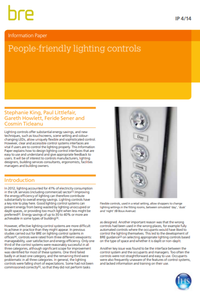People-friendly lighting controls
BRE (Building Research Establishment) is an independent, research-based consultancy, testing and training organisation, operating in the built environment and associated industries.
People-friendly lighting controls (IP 4/14) was written by Stephanie King, Paul Littlefair, Gareth Howlett, Feride Sener and Cosmin Ticleanu, and published by BRE on 30 May 2014.
In 2012, lighting accounted for 41% of electricity consumption in the UK services sector (including commercial). Improving the energy efficiency of lighting can therefore contribute substantially to overall energy savings.
Lighting controls can allow significant energy savings, and new techniques, such as touchscreens, scene setting and colour changing LEDs, allow flexible and sophisticated control.
Good lighting control systems can prevent energy from being wasted by lighting unoccupied or daylit spaces, or providing too much light when less might be preferred. Energy savings of up to 30 to 40% or more are achievable in some types of building, but clear and accessible system interfaces are necessary if users are to control the lighting properly.
This 8-page information paper explains how to design lighting controls interfaces so that they are easy to use, easy to understand, and give appropriate feedback to users. It is intended for controls manufacturers, lighting designers, building services consultants, ergonomists, facilities managers and building owners.
Its contents are:
- Introduction
- BRE lighting controls experiment
- Findings
- Conclusions and recommendations
- References
[edit] Related articles on Designing Buildings Wiki
- Adequate lighting.
- BRE articles on Designing Buildings Wiki.
- BRE Buzz articles on Designing Buildings Wiki.
- BREEAM.
- Building Research Establishment.
- Commercial lighting.
- Daylight lighting systems.
- General lighting v task lighting.
- Health and wellbeing impacts of natural and artificial lighting.
- Human-centric lighting.
- Lighting and energy efficiency.
- Lighting control systems.
- Lighting.
- Smart lighting market to 2020.
- Smart office lighting.
Featured articles and news
A change to adoptive architecture
Effects of global weather warming on architectural detailing, material choice and human interaction.
How big is the problem and what can we do to mitigate the effects?
Overheating guidance and tools for building designers
A number of cool guides to help with the heat.
The UK's Modern Industrial Strategy: A 10 year plan
Previous consultation criticism, current key elements and general support with some persisting reservations.
Building Safety Regulator reforms
New roles, new staff and a new fast track service pave the way for a single construction regulator.
Architectural Technologist CPDs and Communications
CIAT CPD… and how you can do it!
Cooling centres and cool spaces
Managing extreme heat in cities by directing the public to places for heat stress relief and water sources.
Winter gardens: A brief history and warm variations
Extending the season with glass in different forms and terms.
Restoring Great Yarmouth's Winter Gardens
Transforming one of the least sustainable constructions imaginable.
Construction Skills Mission Board launch sector drive
Newly formed government and industry collaboration set strategy for recruiting an additional 100,000 construction workers a year.
New Architects Code comes into effect in September 2025
ARB Architects Code of Conduct and Practice available with ongoing consultation regarding guidance.
Welsh Skills Body (Medr) launches ambitious plan
The new skills body brings together funding and regulation of tertiary education and research for the devolved nation.
Paul Gandy FCIOB announced as next CIOB President
Former Tilbury Douglas CEO takes helm.
UK Infrastructure: A 10 Year Strategy. In brief with reactions
With the National Infrastructure and Service Transformation Authority (NISTA).
Ebenezer Howard: inventor of the garden city. Book review.
Airtightness Topic Guide BSRIA TG 27/2025
Explaining the basics of airtightness, what it is, why it's important, when it's required and how it's carried out.























